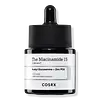What's inside
What's inside
 Key Ingredients
Key Ingredients

 Benefits
Benefits

 Concerns
Concerns

No concerns
 Ingredients Side-by-side
Ingredients Side-by-side

Water
Skin ConditioningGlycerin
HumectantNiacinamide
SmoothingHydrogenated Poly(C6-14 Olefin)
EmollientCaprylic/Capric Triglyceride
Masking1,2-Hexanediol
Skin ConditioningPolyglyceryl-3 Methylglucose Distearate
EmulsifyingMethyl Trimethicone
Skin ConditioningCetearyl Alcohol
EmollientMilk Protein Extract
Broussonetia Kazinoki Root Extract
Skin ConditioningPearl Extract
AntioxidantMelissa Officinalis Leaf Extract
Skin ConditioningGlycyrrhiza Uralensis Extract
EmollientMorus Alba Bark Extract
Skin ConditioningPanthenol
Skin ConditioningCentella Asiatica Extract
CleansingFicus Carica Fruit Extract
HumectantOryza Sativa Bran Extract
Skin ConditioningLaminaria Japonica Extract
Skin ProtectingEclipta Prostrata Leaf Extract
Skin ConditioningPyrus Malus Fruit Extract
Skin ConditioningMalva Sylvestris Extract
AstringentAlchemilla Vulgaris Extract
AstringentAchillea Millefolium Extract
CleansingVeronica Officinalis Extract
Skin ConditioningMentha Piperita Leaf Extract
Skin ConditioningPrimula Veris Extract
Skin ConditioningBeta-Glucan
Skin ConditioningGlutathione
Hydrolyzed Hyaluronic Acid
HumectantCeramide NP
Skin ConditioningCamellia Japonica Leaf Extract
Skin ConditioningCamellia Sinensis Leaf Extract
AntimicrobialVigna Radiata Seed Extract
Skin ConditioningTricholoma Matsutake Extract
Skin ConditioningGalactomyces Ferment Filtrate
HumectantEthylhexylglycerin
Skin ConditioningGalactoarabinan
Carbomer
Emulsion StabilisingTromethamine
BufferingSodium Stearoyl Glutamate
CleansingHydrogenated Lecithin
EmulsifyingSodium Hyaluronate
HumectantAcetyl Glucosamine
Skin ConditioningAlcohol
AntimicrobialGlyceryl Stearate
EmollientPalmitic Acid
EmollientPearl Powder
Myristic Acid
CleansingStearic Acid
CleansingFructooligosaccharides
HumectantSodium Hydroxide
BufferingXanthan Gum
EmulsifyingCellulose Gum
Emulsion StabilisingWater, Glycerin, Niacinamide, Hydrogenated Poly(C6-14 Olefin), Caprylic/Capric Triglyceride, 1,2-Hexanediol, Polyglyceryl-3 Methylglucose Distearate, Methyl Trimethicone, Cetearyl Alcohol, Milk Protein Extract, Broussonetia Kazinoki Root Extract, Pearl Extract, Melissa Officinalis Leaf Extract, Glycyrrhiza Uralensis Extract, Morus Alba Bark Extract, Panthenol, Centella Asiatica Extract, Ficus Carica Fruit Extract, Oryza Sativa Bran Extract, Laminaria Japonica Extract, Eclipta Prostrata Leaf Extract, Pyrus Malus Fruit Extract, Malva Sylvestris Extract, Alchemilla Vulgaris Extract, Achillea Millefolium Extract, Veronica Officinalis Extract, Mentha Piperita Leaf Extract, Primula Veris Extract, Beta-Glucan, Glutathione, Hydrolyzed Hyaluronic Acid, Ceramide NP, Camellia Japonica Leaf Extract, Camellia Sinensis Leaf Extract, Vigna Radiata Seed Extract, Tricholoma Matsutake Extract, Galactomyces Ferment Filtrate, Ethylhexylglycerin, Galactoarabinan, Carbomer, Tromethamine, Sodium Stearoyl Glutamate, Hydrogenated Lecithin, Sodium Hyaluronate, Acetyl Glucosamine, Alcohol, Glyceryl Stearate, Palmitic Acid, Pearl Powder, Myristic Acid, Stearic Acid, Fructooligosaccharides, Sodium Hydroxide, Xanthan Gum, Cellulose Gum
 Reviews
Reviews

Ingredients Explained
These ingredients are found in both products.
Ingredients higher up in an ingredient list are typically present in a larger amount.
1,2-Hexanediol is a synthetic liquid and another multi-functional powerhouse.
It is a:
- Humectant, drawing moisture into the skin
- Emollient, helping to soften skin
- Solvent, dispersing and stabilizing formulas
- Preservative booster, enhancing the antimicrobial activity of other preservatives
Acetyl Glucosamine is an antioxidant and humectant. It is an amino acid sugar and is naturally found in our skin.
The cool thing about this ingredient? It helps the skin produce hyaluronic acid and boost hydration. It also has antioxidant benefits to protect skin cells.
When paired with niacinamide, Acetyl Glucosamine has been shown to be effective at reducing discoloration.
Learn more about Acetyl GlucosamineEthylhexylglycerin (we can't pronounce this either) is commonly used as a preservative and skin softener. It is derived from glyceryl.
You might see Ethylhexylglycerin often paired with other preservatives such as phenoxyethanol. Ethylhexylglycerin has been found to increase the effectiveness of these other preservatives.
Niacinamide is a multitasking form of vitamin B3 that strengthens the skin barrier, reduces pores and dark spots, regulates oil, and improves signs of aging.
And the best part? It's gentle and well-tolerated by most skin types, including sensitive and reactive skin.
You might have heard of "niacin flush", or the reddening of skin that causes itchiness. Niacinamide has not been found to cause this.
In very rare cases, some individuals may not be able to tolerate niacinamide at all or experience an allergic reaction to it.
If you are experiencing flaking, irritation, and dryness with this ingredient, be sure to double check all your products as this ingredient can be found in all categories of skincare.
When incorporating niacinamide into your routine, look out for concentration amounts. Typically, 5% niacinamide provides benefits such as fading dark spots. However, if you have sensitive skin, it is better to begin with a smaller concentration.
When you apply niacinamide to your skin, your body converts it into nicotinamide adenine dinucleotide (NAD). NAD is an essential coenzyme that is already found in your cells as "fuel" and powers countless biological processes.
In your skin, NAD helps repair cell damage, produce new healthy cells, support collagen production, strengthen the skin barrier, and fight environmental stressors (like UV and pollution).
Our natural NAD levels start to decline with age, leading to slower skin repair, visible aging, and a weaker skin barrier. By providing your skin niacinamide, you're recharging your skin's NAD levels. This leads to stronger, healthier, and younger looking skin.
Another name for vitamin B3 is nicotinamide. This vitamin is water-soluble and our bodies don't store it. We obtain Vitamin B3 from either food or skincare. Meat, fish, wheat, yeast, and leafy greens contain vitamin B3.
The type of niacinamide used in skincare is synthetically created.
Learn more about NiacinamideWater. It's the most common cosmetic ingredient of all. You'll usually see it at the top of ingredient lists, meaning that it makes up the largest part of the product.
So why is it so popular? Water most often acts as a solvent - this means that it helps dissolve other ingredients into the formulation.
You'll also recognize water as that liquid we all need to stay alive. If you see this, drink a glass of water. Stay hydrated!
Learn more about WaterXanthan gum is used as a stabilizer and thickener within cosmetic products. It helps give products a sticky, thick feeling - preventing them from being too runny.
On the technical side of things, xanthan gum is a polysaccharide - a combination consisting of multiple sugar molecules bonded together.
Xanthan gum is a pretty common and great ingredient. It is a natural, non-toxic, non-irritating ingredient that is also commonly used in food products.
Learn more about Xanthan Gum